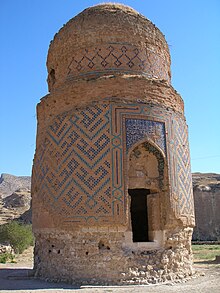User:Rupert Clayton/Mausoleum of Zeynel Bey
| Mausoleum of Zeynel Bey | |
|---|---|
 Mausoleum of Zeynel Bey | |
| Religion | |
| Affiliation | Islam |
| Location | |
| Location | |
| Geographic coordinates | 37°42′52.2″N 41°24′29.7″E / 37.714500°N 41.408250°E
Location of the Mausoleum of Zeynel Bey, Hasankeyf |
| Architecture | |
| Type | Türbe |
| Style | Anatolian Beyliks Islamic architecture |
| Completed | AH 878 (1473/1474) |
| Specifications | |
| Dome dia. (outer) | 9 metres (30 ft) |
| Materials | brick with faïence decoration |
The Mausoleum of Zeynel Bey (Turkish: Zeynel Bey Türbesi) also known as the Tomb of Zeynel Bey is a mausoleum in Hasankeyf, Eastern Anatolia, Turkey erected in AH 878 (1473/1474) for Zainal (Zeynel in modern Turkish), the son of the Aq Qoyunlu Turkmen ruler Uzun Hassan. It was likely commissioned by Uzun Hassan, or possibly by Zainal's elder brother, Khalīl. According to the German historian of Islamic art Michael Meinecke, "In form and decoration, the mausoleum of Zainal is without parallel in the region".[1]
Background[edit]
During the second half of the 15th century, Hasankeyf was governed by Ayyubid Kurdish rulers who owed allegiance to the Turkmen Aq Qoyunlu confederation. The Aq Qoyunlu dynasty was headed by Uzun Hassan from 1452 to 1478.
Uzun Hassan's initial capital was at Amida (modern Diyarbakır), which he gained from his brother Jihangir in 1452.[2] From there, Uzun Hassan embarked on a campaign of expanding his territory at the expense of the Kara Koyunlu.[2] Hasankeyf was one of the first towns to acknowledge Uzun Hassan's overlordship, in an agreement signed by the Ayyubid emir in 1455.[2] While Uzun Hassan managed to extend his influence throughout much of the Diyar Bakr and Jazira during the 1450s, the emir of Hasankeyf rebelled in 1460, attempting to take control of Siirt.[2] Uzun Hassan responded by attacking Hasankeyf in 1461; he finally captured the town in 1462 after a six-month seige.[2]
Following his defeat of the Kara Koyunlu in Iran (1467–69), Uzun Hassan moved his capital to Tabriz.[2] Encouraged by the Venetian ambassador Caterino Zeno, Uzun Hassan engaged the Ottoman army near Erzincan in 1471 and at Tercan in 1473.[3] This campaign concluded with Uzun Hassan's defeat by Mehmed II at the Battle of Otlukbeli (also near Erzincan) in August 1473.[4] Hassan's army was primarily composed of light cavalry, whereas the Ottoman forces were also armed with rifles and cannon. The result was an almost total rout of the Aq Qoyunlu forces. While Uzun Hassan survived, his son Zeynel Bey was killed in battle. Hassan agreed not to attack the Ottomans again, and retreated to Tabriz. Following the defeat at Otlukbeli, it seems that Hassan was challenged by insurrections from several of his sons, including Ogurlu Mohamed, who captured Shiraz around 1473. But it appears that his son Khalil remained loyal and was appointed successor upon Hassan's death in 1478.
Construction[edit]

Significance in Islamic architecture[edit]
Footnotes[edit]
References[edit]
- ^ Meinecke 1996, p. 78.
- ^ a b c d e f Sinclair 1989, p. 404.
- ^ Babinger 1978, p. 306.
- ^ Babinger 1978, pp. 314–315.
Sources[edit]
- Babinger, Franz (1978). Mehmed the Conqueror and his Time. Bollingen Series XCVI. edited by William C. Hickman, translated by Ralph Manheim. Princeton University Press. ISBN 0-691-09900-6.</ref>
- Gabriel, Albert (1940), "Ḥiṣn Kayfa", Voyages archéologiques dans la Turquie orientale [Archeological Travels in Eastern Turkey] (in French)
- Meinecke, Michael (1996), "3. Hasankeyf/Ḥiṣn Kaifā on the Tigris: A Regional Center on the Crossroad of Foreign Influences", Patterns of Stylistic Changes in Islamic Architecture: Local Traditions Versus Migrating Artists, New York University Press
- Sinclair, T.A. (1989), Eastern Turkey: An Architectural and Archaeological Survey, vol. 3, Pindar Press, ISBN 0907132340
External links[edit]
Remove nowiki from following text when moving to mainspace
{{DEFAULTSORT:Zeynel Bey}} [[Category:Buildings and structures in Hasankeyf]] [[Category:Anatolian Beyliks architecture]] [[Category:Mausoleums in Turkey]] [[Category:1470s architecture]] [[Category:Buildings and structures completed in 1474]]

